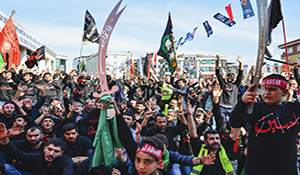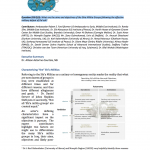Aims of Shia Militias Post-ISIL

Question (R3 QL3): What are the aims and objectives of the Shia Militia Groups following the effective military defeat of Da’esh?
Author | Editor: Astorino-Coutois, A. (NSI, Inc).
Referring to the Shi’a Militias as a unitary or homogenous entity masks the reality that what are now dozens of groups in Iraq were established at different times and for different reasons, and thus have different allegiances and goals. 1 Dr. Daniel Serwer of Johns Hopkins SAIS puts it succinctly, “Not all ‘Shi’a militia groups’ are created equal.” An actor’s defining characteristics have a significant impact on the objectives it pursues. The expert contributors highlight two factors we might use to differentiate the many Shi’a militia groups in Iraq, their aims, objectives and likely post-ISIS actions. These are: 1) the extent to which the group is led by and owes allegiance to Iran; and 2) the span of its concerns and interests. How groups rate on these two factors will tell us a lot about what we should expect of them following the effective defeat of ISIS (see graphic).
Autonomy. Contributors to this Quick Look tended to differ on where the balance of control over the Shi’a militias rests. Some see the Shi’a PMF groups as primarily under the control of Iran, and thus motivated or directed largely by Iranian interests (i.e., they have very little autonomy.) If this is the case, knowing the interests of the leaders of these groups will tell us little about their actions). Other experts view the militias as more autonomous and self- directed albeit with interests in common with Iran in which case their interests are relevant to understanding their objectives. In reality, there are groups that swear allegiance to the Supreme Leader in Iran, those that follow Ayatollah al Sistani, and still other groups that respond only to their commanders. In an interview with the SMA Reachback team, Dr. Anoush Ehteshami a well-known Iran scholar from Durham University (UK) points out that Iran has “shamelessly” worked with groups it controls as well as those that it does not because it sees each variety as a “node of influence” into Iraqi society. As in previous Reachback Quick Looks2, a number of the SMEs note that Iran is best served by taking a low- key approach in Iraq. Ehteshami argues that ultimately Iran has little interest in appearing to control the Shi’a militias: “the last thing that they want is to be seen as a frontline against Daesh” as this would reinforce the Sunni versus Shi’a sectarian, Saudi-Iranian rivalry undercurrents of the conflict against ISIS. In fact he argues that Iran prefers to work with the militias rather than the central government – which is susceptible to political pressure that Iran cannot control in order to “maintain grass root presence and influence … of the vast areas of Iraq which are now Shia dominated.”
Ambition. A second factor that distinguishes some militia groups is the span of their key objectives and ambition. In discussing militia objectives, some SMEs referenced groups with highly localized interests, for example groups that were established more recently and primarily for the purpose of protecting family or neighborhood. Others mentioned (generally pro-Iran) groups with cross-border ambitions. However, the major part of the discussion of militia objectives centered on more-established and powerful groups with national-level concerns.
Key Objectives
Most experts mentioned one or all of the following as key objectives of the Shi’a militia, at present and in post-ISIS Iraq. Importantly, many indicate that activities in pursuit of these objectives are occurring now – the militias have not waited for the military defeat of ISIS.
Controlling territory and resources
For groups with very localized concerns this objective may take the form of securing the bounds of an area, or access to water in order to protect family members or neighborhoods. For groups with broader ambitions, American University of Iraq Professor Christine van den Toorn argues that controlling territory and resources is a means to these militias’ larger political goals. As in the past, this may entail occupying or conducting ethnic cleansing of areas of economic, religious and political significance (e.g., Samarrah, Tel Afar, former Sunni areas of Salahuldeen Province near Balad.) Here too Anoush Ehteshami suggests that different militia groups have different allegiances and motives: some are “keen to come flying a Shia flag into Sunni heartlands and are determined to take control of those areas.” A number of authors indicate that a specific project of Iran-backed militias possibly with cross-border ambitions would be to secure Shi’a groups’ passage between Iraq and Syria (van den Toorn suspects this would be north or south of Sinjar adding that Kurds would prefer that the route “go to the south, through Baaj/ southern Sinjar and not through Rabiaa, which they want to claim.”)
Consolidating political power and influence
Anoush Ehteshami believes that the Shi’a militia groups are keen to gain as much “control of government as possible, as quickly as possible.” These groups are actually new to Iraqi politics and realize that once the war is over their influence and role in the political order may end. Many of the experts identified the primary objective of militia groups with broader local or national ambitions as increasing their independence from, and power relative to Iraqi state forces. Christine van den Toorn relates an interesting way that some Shi’a militias are working to expand their influence: by forging alliances with “good Sunnis” or “obedient Sunnis.” In fact, she reports that the deals now being made between some Sunni leaders and Shia militia/PMF are in essence “laying the foundation of warlordism” in Iraq and potentially cross-nationally. Many experts singled out the law legalizing the militias as making it “a shadow state force” or an Iraq version of the Iranian Islamic Revolutionary Guard Corps (RGC) – a clear victory for those seeking to institutionalize the political wealth, and likely economic wealth of the militias.
Dr. Harith Hasan al-Qarawee of Brandeis University agrees that the primary goal of the militia groups with national or cross-national ambitions is to gain political influence in Iraq in order to: “to improve their chances in the power equation and have a sustained access to state patronage.” As a result, he anticipates that they will continue to work to weaken the professional, non-sectarian elements of the Iraqi Security Forces, and would accept reintegration into the Iraqi military only if it affords them the same or greater opportunity to influence the Iraqi state than what they currently possess. Finally, a number of the experts including Dr. Randa Slim of the Middle East Institute, mention that an RGC-like, parallel security structure in Iraq will also serve Iran as a second “franchisee” along with Hezbollah in Lebanon, and allow export of “military skillsets/expertise/knowhow, which can be shared with fellow Shia groups in the Gulf region.”
Eliminating internal opposition from Sunni and Kurds
Omar Al-Shahery, a former deputy director in the Iraqi Defense Ministry, along with a number of other SME contributors believe that after the Sunni Arabs are “taken out of the equation” the Kurds are the militias’ “next target.” Dr. Daniel Serwer (Johns Hopkins SAIS) expects that Shi’a forces will remain in provinces that border Kurdistan, if not at the behest of Iran, then certainly in line with Iran’s interest in avoiding an expanded and independent Kurdistan in Iraq. Al Shahery (Carnegie Mellon) points to this as the impetus for militias pushing the Peshmerga out of Tuzkurmato south of Kirkuk. Similarly, Shi’a concern with Saudi support reaching Sunni groups opposed to the expansion of Shi’a influence in Iraq was motivation for occupying Nukhaib (south Anbar) and cutting Sunni forces off from a conduit to aid. Finally, Al-Shahery raises the possibility that the ultimate goal of the most ambitious militia groups is in fact to form an “integrated strike force” that can operate cross-nationally. This is evidenced he argues, by the centralization of the command structure of the forces operating in Syria.
What to Expect after Mosul
The following are some of the experts’ expectations about what to expect from the Shi’a militias in the short to mid-term. See the author’s complete submission in SME input for justification and reasoning.
- Re-positioning. Iran will encourage some militia forces to relocate to Syria to help defend the regime. However, Iran also will make sure that the “Shia militias which have been mobilized, are going to stay mobilized” as a “pillar of Iran’s own influence in Iraq” (Dr. Anoush Ehteshami, Durham University, UK)
- Inter and intra- sectarian conflict. The PMFs will play a “very destabilizing” role in Iraq if not disbanded or successfully integrated into a non-sectarian force. The present set-up will result in renewed Sunni-Shia tensions, Sunni extremism (Dr. Monqith Dagher, IIACSS and Dr. Karl Kaltenthaler, University of Akron); Shi’a-Shi’a violence (Dr. Sarhang Hamasaeed, USIP); and/or violent conflict with the Kurds (Dr. Daniel Serwer, Johns Hopkins SAIS; Omar Al-Shahery, Carnegie Mellon)
- New political actors. Select militia commanders will leave the PMF to run for political office, accept ministerial posts (Dr. Daniel Serwer, Johns Hopkins SAIS) and/or “major political players in Baghdad” will attempt to place them in important positions in the police or Iraqi security force positions. (Dr. Diane Maye, Embry-Riddle)
Following ISIS defeat in Iraq …
Contributing Authors
Ford, R. (Middle East Institute), Slim, R. (Middle East Institute), Abouaoun, E. (US Institute of Peace); al-Qarawee, H. (Brandeis University), Al-Shahery, O. (Carnegie Mellon University), Atran, S. (ARTIS), Dagher, M. (IIACSS), Gulmohamad, Z. (University of Sheffield), Ehteshami, A. (Durham University), Kaltenthaler, K. (University of Akron), Mansour, R. (Chatham House), Hamasaeed, S. (US Institute of Peace), Maye, D. (Embry Riddle University), Nader, A. (RAND), Serwer, D. (Johns Hopkins School of Advanced International Studies), van den Toorn, C. (American University of Iraq, Sulaimani), Wahab, B. (Washington Institute for Near East Policy)

Comments